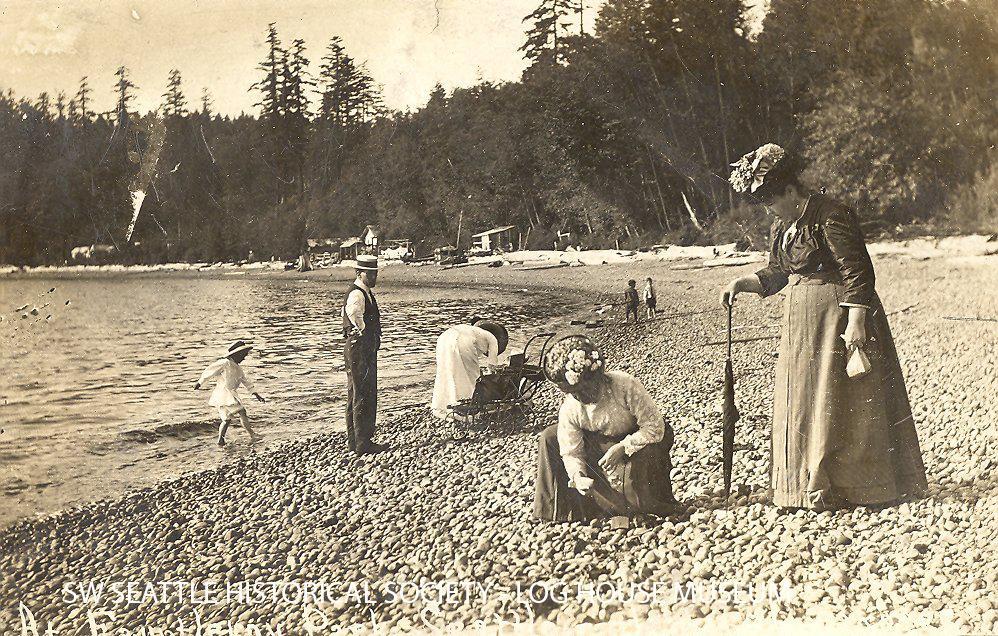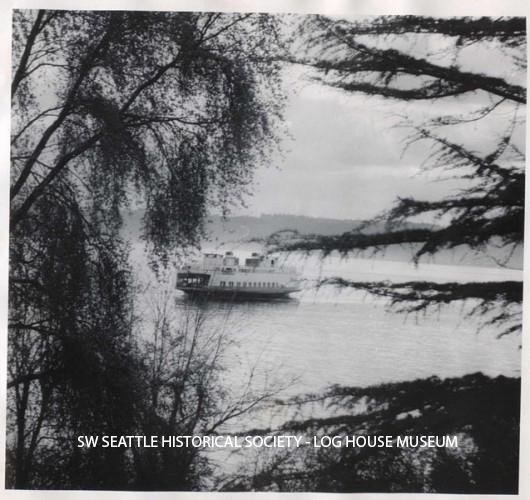At the far southwest corner of Seattle you will find the Fauntleroy neighborhood facing Vashon Island and the Olympic Mountains to the west.
Native American Presence
Native Americans appreciated and used Fauntleroy Cove well before white pioneers arrived. A 1915 excavation to widen Fauntleroy Way uncovered evidence of an ancient Native American burial ground near where Fauntleroy Creek flows into Puget Sound. Local residents have found middens of clamshells indicating that Fauntleroy Cove had been a Native American clamming and fishing site into the 19th Century. At a very low tide one can still see what Native Americans call a ‘spirit boulder’ south of the ferry dock. Native Americans claim that the boulder, Psai-Yah-hus, is the dormant spirit that lives underground and caused landslides and earthquakes.

Explorers and Pioneers
Lt. Charles Wilkes was the first of the white explorers to discover the cove. In 1841 the US Navy Exploring Expedition, under Lt. Wilkes, named Brace Point and Point Williams. In 1857 Lt. George Davidson anchored his brig in the cove where he observed Indians camping, fishing and clamming. At the time Lt. Davidson was engaged to Ellinor Fauntleroy and set out to impress his future father in law by naming prominent features after folks in the Fauntleroy family. Fauntleroy cove was named after his future father-in-law, R. H. Fauntleroy. Davidson, impressed with the spectacular view of the Olympics to the west, named Mt. Ellinor, for his bride to be. He also named The Brothers, Mt. Constance and Mt. Rose for members of his future family. The names and the spectacular vista from the cove are still with us.
In 1881 Swedish sea captain Charles Peterson built a cabin at Brace Point and began to farm. He eventually applied for and received a Homestead claim.
Adams, Colman and Kilbourn
Build a Community and Connect it to Seattle
During the Klondike Gold Rush John Adams made money by operating an Alaskan outfitting company on First Avenue. In 1905 he invested his profits in 300 acres at Fauntleroy. That same year a successful Seattle businessman, James Colman, bought 17 acres along the cove from Adams. Colman persuaded several of his friends from Plymouth Congregational Church to build summer cabins at the cove. Soon permanent homes replaced the summer tents and cabins. John Adams set up a small store, a small shingle mill at Rose Street and began to promote a streetcar line to isolated Fauntleroy. By 1907 a streetcar line was built by Dr. Edward Kilbourn that connected downtown Seattle with isolated Fauntleroy. That same year, 1907, all of West Seattle, including Fauntleroy, was annexed to the city of Seattle.
Adams, James Colman and Dr. Kilbourne set out to build the remote Fauntleroy settlement into a community. On July 25, 1908 Fauntleroy Church was ‘built in a day’ on land donated by Adams, labor contributed by the community, and lumber donated by Laurence Colman, son of James Colman.
The Olmsted Plan of that era set out to establish a system of parks to be connected by boulevards in Seattle. The Olmsted plan recommended including land at Point Williams as part of their system. In time this was done and Lincoln Park was the result.
Laurence Colman, and Dr. Kilbourne had been instrumental in building the downtown Seattle YMCA. By 1914 they had planned and built a gym and recreation center next to the Fauntleroy Church. This became the Fauntleroy YMCA and, along with the church, is a strong part of the community today.
The streetcar line, roads and Colman’s dock at the cove combined to bring more people to the area. In 1917 Adams sold land to the Seattle School district for a permanent Fauntleroy School. David Galbraith recalls a school experience that reminds us of the isolated primeval condition of Fauntleroy in those early days. “We were walking down the lane to Fauntleroy School and came upon a crew of loggers cutting down a fir tree about nine feet across. To avoid injury, the loggers made us stay put until the tree was felled. We then convinced one of the loggers to come to school to explain why we were late. That tree was one of the last of the old growth fir in these woods – and it was cut for firewood.” With the church, YMCA, parks and school, people of Fauntleroy succeeded in their goal to build a community suitable for families. In the words of Seattle Parks historian Don Sherwood, “Laurence Colman and others pioneered the practice in Seattle of nipping delinquency in the bud by promoting organization of youth groups.”
Among the important additions to the Fauntleroy community was the Kenney Presbyterian Home for the Retired which opened in 1907. The striking building was patterned after Independence Hall in Philadelphia. It is still in operation and is now expanding. In 1920 Dr. Frederick Slyfield and Dr. John Nelson opened the Laurel Beach Sanatorium just south of Brace Point. The quiet natural setting seemed an ideal place for the treatment of tuberculosis victims. Following WWII new drugs reduced the need for the sanatorium and it closed in 1957.
Puget Sound’s ‘ mosquito fleet’ buzzed about the area in the early 1900’s. Grace Hanson remembers “The 8:15 whistle of the Indianapolis, on its morning run from Tacoma to Seattle, signaled us children of Fauntleroy that it was time to scurry off to school. If neighborhood kids had good attendance at Fauntleroy School and Sunday School, Mr. Colman would take us camping to Horsehead Bay across the Sound.” By the 1920’s the Kitsap County Transportation Company ran a regular Fauntleroy-Vashon-Harper run. Today the Washington State Ferry system runs this service.
In the 1930s the WPA, CWA and CCC’s helped develop Lincoln Park by clearing underbrush, building trails, seawalls, playgrounds and tennis courts. In 1941 the Colman family continued their community service by building Colman Pool at Pt. Williams and donating it to the community. The pool replaced the old tide pool swimming hole at Pt. Williams.
A small business district evolved at the intersection of 45th and Wildwood but Fauntleroy though never to be a large commercial center it still provides services and gathering places for the community.
Following December 7, 1941, the Army set up a small post at Brace Point. Gary Sparks at Brace Point fondly remembers the young soldiers from New York City who were stationed at Brace Point. “An Army platoon was positioned at Brace Point soon after the outbreak of the War. A machine gun was set in a pit surrounded by sandbags. Soldiers stayed in a tarpaper building. A searchlight tower overlooked the site. Barbed wire and a bomb shelter completed the Brace Point ‘stronghold.’ A garage nearby held a 105 mm Howitzer. Not a round was fired. There were other gun emplacements around Elliot Bay as Seattle prepared for the attack that never happened.” By 1944 the Brace Point site was abandoned and the unit was transferred to Texas.

Fauntleroy Community Activism Continues
Post World War II expansion brought more people into the neighborhood. By the 1950’s homebuilding expanded into the hillsides above Fauntleroy Cove. The spirit of community building continued.
Fauntleroy Park was bought from the Fenton Family in 1972 and is one of Seattle’s few natural parks. These 28 acres preserve the headwaters of Fauntleroy Creek as well as many plant species. Students, youth groups, as well as veterans of the CCC’s, have all participated in the plantings that have re-created an oxygen rich habitat for aquatic animals, insects and wildlife along the creek.
A fish ladder in Seattle? Indeed, thanks to Judy Pickens, the Fauntleroy Creek Fish Ladder restoration project was begun in 1989. The Friends of Fauntleroy Creek, in cooperation with the City of Seattle, completed the project. Over the years Coho salmon have been released by schoolchildren. Volunteers count the return each fall. Community volunteers and Seattle Summer Youth Employment, World Conservation Corps, Fauntleroy Church, Consejo Counseling and Referral Service and the Seattle Public Utilities are among those who have contributed to the program.
Morey Skaret established and maintains Captain’s Park which overlooks the cove and the ferry dock. It was Captain Skaret’s intention to honor all who have plied the local waters including Native Americans who at one time camped at the sight. Captain Morey Skaret continues to share the history of Fauntleroy with young and old in the community.
Cove Park was dedicated April 9, 2000 just north of the Ferry dock. The active Fauntleroy Community Association initiated the project led by Mardi Clements, Bruce Butterfield, Gary Dawson, Morey Skaret, Judy Pickens and Phil Sweetland, among others. Volunteers, patron gifts and city grants were part of this project. The park is a haven for walkers and boaters. Artist Tom Jay’s sculptures remind visitors of the Native American history at Fauntleroy.
Fauntleroy has an impressive roll call of prominent people in the history of Seattle. A partial list includes the pioneers, James Colman, Laurence Colman, Ken Colman, John Adams, Dr. Edward Kilbourn, prominent Seattle architect Joe Wilson, mountaineers Lou and Jim Whittaker, wildlife photographer Art Wolf, retired Seattle Police and Coast Guard Captain Morey Skaret, Boeing engineer Ware Lanze who helped design the lunar orbiter, Thor Kalstrom who used photos from that same orbiter to map the moon and select the landing site for the Apollo moon landing.
Sources:
“Fauntleroy Legacy” by Roy Morse and Richard Brown, 1989, “West Side Story” edited by Clay Eals and published by West Seattle Herald, 1987, “Morey’s Bench by Morey Skaret, “History of Seattle Parks System” by Don Sherwood, Fauntleroy Community Church Archives, community members Dr. Jack Pierce, Roy and Beth Morse, Jane Wilson MacGowan, Morey Skaret, Judy Pickens, David Galbraith, Grace Hanson, Gary Sparks, Ware Lanze by, Ron Richardson, July 21, 2007




